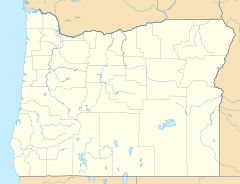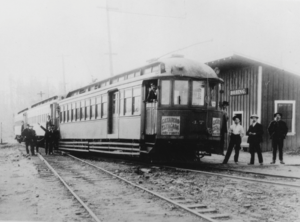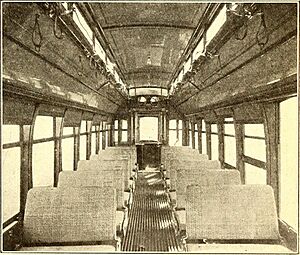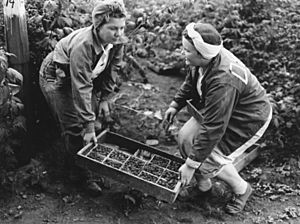Boring, Oregon facts for kids
Quick facts for kids
Boring
|
|
|---|---|
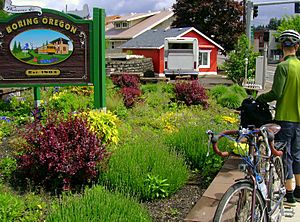
Cyclists at the west entrance to Boring on Oregon Route 212
|
|
| Motto(s):
"The most exciting place to live!"
|
|
| Country | United States |
| State | Oregon |
| County | Clackamas |
| Settled | 1856 |
| Platted | 1903 |
| Named for | William Harrison Boring |
| Area | |
| • Total | 30.0 sq mi (77.7 km2) |
| Elevation | 505 ft (154 m) |
| Population
(2010)
|
|
| • Total | 7,762 |
| • Density | 258.73/sq mi (99.90/km2) |
| Time zone | UTC-8 (Pacific (PST)) |
| • Summer (DST) | UTC-7 (PDT) |
| ZIP Codes |
97009
|
| Area code(s) | 503 and 971 |
| Sister cities | Dull, Scotland Bland, Australia |
| GNIS feature ID | 2805447 |
Boring is a small community located in Clackamas County, Oregon, in the United States. It sits in the foothills of the Cascade mountains, about 12 miles (19 km) southeast of Portland.
This community is named after William Harrison Boring, a soldier and pioneer. His family started a farm here in 1856, even before Oregon became a state. Boring officially became a town in 1903. This happened after the Portland Railway, Light and Power Company built an electric train line through the area.
That old train line is now a popular trail called the Springwater Corridor. It's great for walking, running, and biking. The trail starts in Boring and goes all the way to downtown Portland. Did you know there's an extinct volcanic field called the Boring Lava Field? It's named after the community and stretches from Boring to Portland.
For a long time, Boring was a big center for the timber industry in the Pacific Northwest. This was especially true around World War I. Today, you'll find many plant nurseries and farms here.
Boring is often mentioned in lists of places with funny or unusual names. In 2012, Boring became a "sister city" with a village in Scotland called Dull. Later, they were joined by Bland, Australia, forming a group called the "Trinity of Tedium."
Contents
Exploring Boring's Past
How Boring Got Its Name
The land where Boring is located was once a lava field. The Boring Lava Field, named after the community, is just north of Boring. It has about 80 old lava vents from volcanic activity that happened millions of years ago.
Boring gets its name from William Harrison Boring. He was from Illinois and started farming here in 1874. He even gave land for the community's first schoolhouse. William was a veteran of the Civil War. His half-brother, Joseph, had settled in the area even earlier, in 1856.
The Electric Train Era
Boring was officially mapped out in 1903 as "Boring Junction." This was because of the new railway line built by the Portland Railway, Light and Power Company. The post office was also set up and named Boring that same year.
An electric trolley ran on this railway line. It traveled from Portland through Gresham and Boring, all the way to Cazadero. This trolley started carrying passengers in 1905. It made travel much faster. A trip from Boring to Portland by horse and buggy took about six hours. But with the trolley, it only took one hour!
After World War II, more people started owning cars. Because of this, the trolley stopped carrying passengers to Portland. The railway eventually closed down. Now, much of the old railway line is part of the Springwater Corridor. This is a popular rail trail for walking, running, and cycling.
A Community with a Unique Name
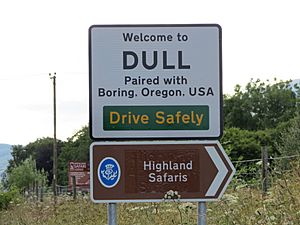
The unusual name "Boring" often makes people smile. Locals actually like the name and use it for many businesses. This creates funny road signs for visitors. People who wanted Boring to become a recognized village even used the slogan "The most exciting place to live!"
In 2011, a woman from Scotland suggested pairing Boring with a village called Dull. She passed through Boring on a bike trip. In June 2012, Boring agreed to "pair" with Dull. This idea was meant to attract tourists to both places because of their names. Dull is a tiny village with only 84 residents, while Boring has about 8,000 people.
In 2013, another place joined the fun: Bland Shire in Australia. These three communities—Dull, Boring, and Bland—formed a "League of Extraordinary Communities." This grouping encourages travel and promotes all three places. That same year, the Boring Station Trailhead Park was finished. It's on the spot where the original train station used to be.
Boring's Location and Weather
Where is Boring?
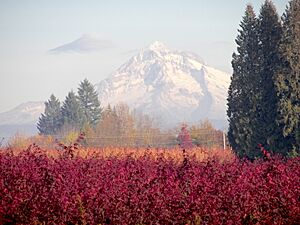
Boring is located at the northern end of the eastern Willamette Valley. It sits in the foothills of the Cascade mountains, right at the base of Mount Hood. Mount Hood is a major mountain in Oregon.
The community covers about 30 square miles (77.7 sq km) of Clackamas County. Boring is considered part of the Portland metropolitan area. It's about 12 miles (19 km) southeast of Portland's city limits.
Boring's landscape is quite hilly. Its elevation ranges between 548 feet (167 m) and 755 feet (230 m). Several creeks flow west through the community into the Clackamas River.
Boring's Climate
Boring has a warm-summer Mediterranean climate. This means it has warm, dry summers and cool, rainy winters. The community gets a lot of rain each year, about 54 inches (1378 mm). This is more than nearby cities like Portland or Gresham.
Boring gets more rain because it's in the Cascade foothills. This puts it at a higher elevation than other towns in the Portland area. The first frost in Boring usually happens in early November. The last frost is typically in early April.
Yearly Weather Data
| Climate data for Boring, Oregon | |||||||||||||
|---|---|---|---|---|---|---|---|---|---|---|---|---|---|
| Month | Jan | Feb | Mar | Apr | May | Jun | Jul | Aug | Sep | Oct | Nov | Dec | Year |
| Mean daily maximum °F (°C) | 46 (8) |
51 (11) |
56 (13) |
61 (16) |
68 (20) |
73 (23) |
80 (27) |
81 (27) |
75 (24) |
64 (18) |
52 (11) |
46 (8) |
63 (17) |
| Mean daily minimum °F (°C) | 34 (1) |
36 (2) |
38 (3) |
41 (5) |
46 (8) |
50 (10) |
54 (12) |
54 (12) |
50 (10) |
44 (7) |
39 (4) |
35 (2) |
44 (7) |
| Average precipitation inches (mm) | 7.53 (191) |
6.16 (156) |
5.51 (140) |
4.36 (111) |
3.55 (90) |
2.45 (62) |
.97 (25) |
1.26 (32) |
1.26 (32) |
2.36 (60) |
7.76 (197) |
8.04 (204) |
54.26 (1,378) |
| Source: Zip Data Maps Profile for Zip Code 97009 | |||||||||||||
Boring's Economy and Jobs
After it became a railroad town, Boring grew into a center for the timber industry. This started before World War I and continued for much of the 20th century. One of the first sawmills, Hillyard Sawmill, opened in the 1890s. It produced a lot of lumber every day.
Today, Vanport International is a main lumber company in Boring. They export lumber, but also process timber products.
Boring is also home to many dairy farms, plant nurseries, and berry farms. For example, Liepold Farms supplies produce to the local restaurant chain Burgerville. There are over thirty active plant and tree nurseries in the community.
Another important place is the Mt. Hood Center. It was built in 1974 and is still used today. It's an equestrian center, an event venue, and even has a school called Mt. Hood Center Academy. Boring also has a campus for Guide Dogs For The Blind, Inc. This is the oldest guide dog training program on the US West Coast.
Learning in Boring
The first schoolhouse in Boring was Fern Hill School, built in 1883. The Kelso Schoolhouse opened two years later, in 1885. Another school, Oregonia, was built in 1904.
Today, students in Boring attend schools in two different districts. These are the Oregon Trail and the Gresham-Barlow school districts. Elementary schools in Boring include Naas Elementary and Kelso Elementary. For older students, there's Boring Middle School. High school students go to Sandy High School or Sam Barlow High School.
Boring is also home to Oregon Trail Academy. This is the only public K-12 school in the Northwest that offers the International Baccalaureate program. It opened in 2010. In 2019, this school was ranked among the top schools in the Portland area. Students' test scores in Boring's public schools are generally at or above the national average.
Getting Around Boring
Oregon Route 212 starts in Boring and goes through the center of town. The roads here are taken care of by the Oregon Department of Transportation.
From the 1970s until 2012, Boring was part of the TriMet transit district. This is Portland's public transportation system. However, local business owners asked to remove Boring from the district. They felt they weren't getting enough bus service for the taxes they paid. Their request was approved, and TriMet service in Boring ended in 2013.
The Springwater Corridor is a popular rail trail that begins in Boring. It's used for running, walking, and cycling. This trail follows an old railroad line that once connected Boring and Portland. It ends in downtown Portland.
Boring in Pop Culture
The fictional town in the Disney TV series Gravity Falls was inspired by Boring.
In 2013, Vitaminwater held an event in Boring. They gave Boring and the town of Normal, Illinois, "makeovers." The event in Boring featured music by Santigold and Matt & Kim. It also had comedy performances, including one by Amy Schumer.
In 2018, the Netflix TV series Everything Sucks! was set in Boring. The show focused on students attending the fictional "Boring High School."
Notable People from Boring
- Bob Amsberry (1928–1957), original member of The Mickey Mouse Club
- William H. Boring (1841–1932), Union soldier; founder of town
- Ryan Crouser (1992–), Olympic Gold Medalist in shot put and discus throw
- Alex Hirsch (1985–), storyboard artist, writer and producer at Disney
- Charis Michelsen (1974–), actress, model, and makeup artist
- Ben Musa (1905–1974), Oregon state legislator
- Maria Thayer (1975–), actress and comedian
- Brian Wilbur (1986–), American football quarterback
Sister Communities
Boring is paired with the following communities:


